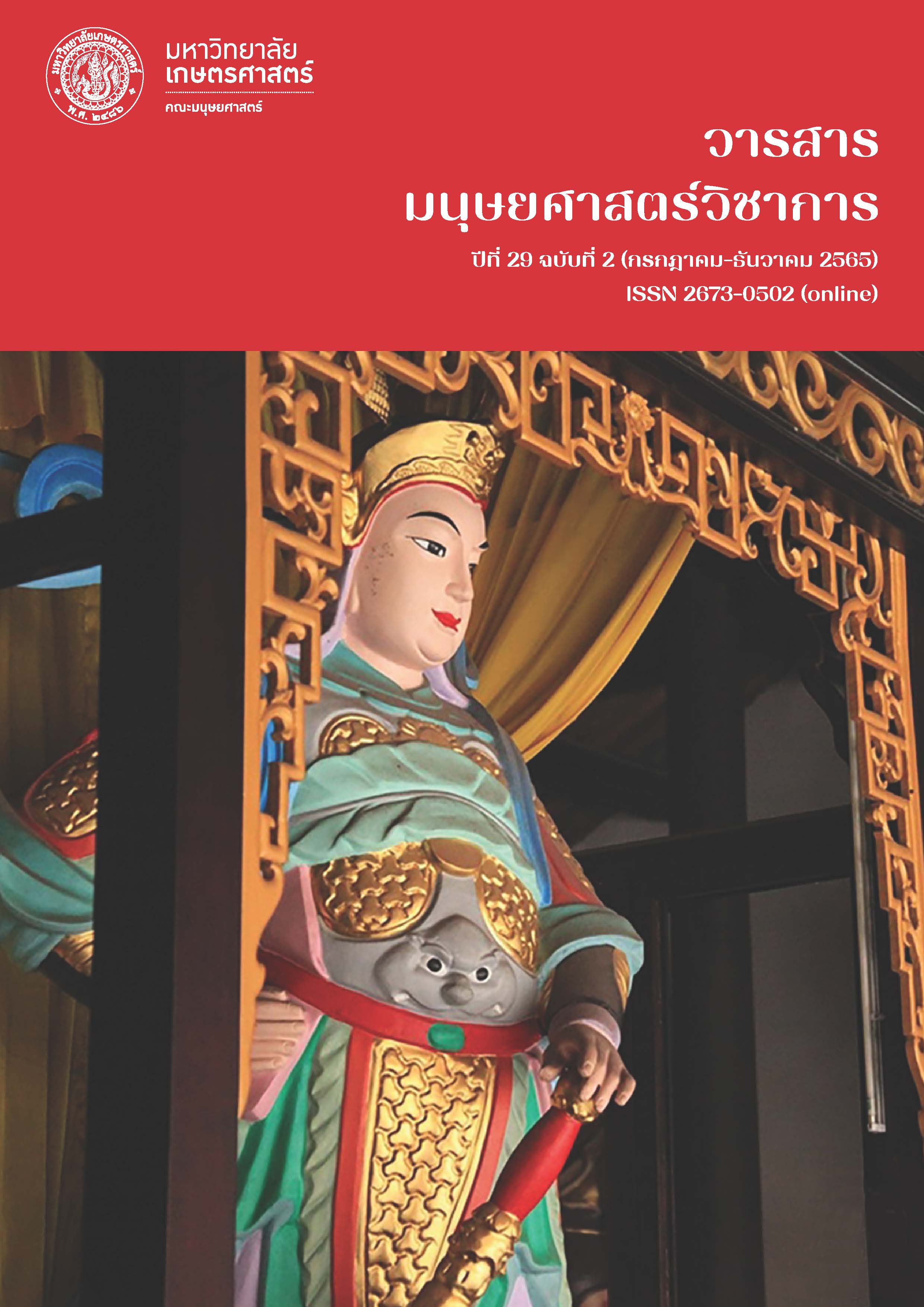Haruki Murakami’s “A Slow Boat to China” Short Stories: Images of Life and Style of Writing
Main Article Content
Abstract
This research has analyzed the images of life in and the style of writing of the selected seven short stories, “A Slow Boat to China”, written by Haruki Murakami during 1980-1982. The three images of life found in all short stories were 1. death 2. isolation and 3. confusion. The research also found that the images of life from the point of view of Murakami were different from those of Japanese traditional works. However, the behaviors of certain characters in some stories subtly reflected traditional Japanese culture especially in terms of “A-ma-e” (depending on others) and “Giri-gatasa” (a strong sense of obligation). Furthermore, this research also pointed out that Murakami’s style of writing was significant in rhythm, emphasis on the use of the first personal pronoun and simplicity.
Article Details

This work is licensed under a Creative Commons Attribution-NonCommercial-NoDerivatives 4.0 International License.
References
ดุสิตา ปริญญาพล. (2559). การวิเคราะห์วิธีคิดและพฤติกรรมผ่านความสัมพันธ์ชาย-หญิงของตัวละครเอกในหนังสือรวมเรื่องสั้นชุด Onna no Inai Otokotachi ของฮารูกิ มูราคามิ. วารสารรามคำแหง ฉบับมนุษยศาสตร์, 35(2), 21-40.
ดุสิตา ปริญญาพล. (2561). ตัวละครเอกชายในวรรณกรรมชุดไตรภาคเนะสุมิกับทัศนคติต่อสังคมของมุระกะมิ ฮะรุกิ. วารสารเครือข่ายญี่ปุ่นศึกษา ฉบับพิเศษ, 8(3), 71-83.
เดือนเต็ม กฤษดาธานนท์. (2558). นวนิยายญี่ปุ่นสมัยใหม่. กรุงเทพฯ: จุฬาลงกรณ์มหาวิทยาลัย.
ราชบัณฑิตยสถาน. (2556). พจนานุกรม ฉบับราชบัณฑิตยสถาน พ.ศ. 2554 (พิมพ์ครั้งที่ 2). กรุงเทพฯ: ราชบัณฑิตยสถาน.
กรุงเทพฯ: กำมะหยี่.
มะซะยะซุ, โฮะซะกะ. (2544). ญี่ปุ่นสมัยโชวะ ประวัติศาสตร์บอกเล่าจากพ่อสู่ลูก. แปลโดยสร้อยสุดา ณ ระนอง และ ปราณี จงสุจริตธรรม. กรุงเทพฯ: มูลนิธิโครงการตำราสังคมศาสตร์และมนุษยศาสตร์.
Brown, C. (2014, February 27). Haruki Murakami now available in 50 languages. Retrieved from https://www.curtisbrown.co.uk/news/haruki-marukami-now-available-in-50-languages.
Guan, B., & Yang, B. (2020). 村上春樹小説における「虚」と「実」:「中国行きのスロウ・ボート」の中国人について. 東アジア文化交渉研究, 関西大学学術リポジトリ, 13, pp. 433-443.
Horiuchi, H. (2007). International Cultural Relations and Teaching Japanese as a Foreign Language.
th Princeton Japanese Pedagogy Forum. Retrieved from https://pjpf.princeton.edu/past-forums.
Okuda, K. & and Okuda, H. (2003). New Trends in Foreign Language Education in the U.S.
Journal of the Faculty of Human Cultures and Sciences, Fukuyama University, 3, pp. 55-67.
シャルル マルタ デュイスシコDwisusilo, S. M. (2008). 村上春樹の初期作品について-背景も視野に入れながら. 岩手大学大学院人文社会科学研究科紀要, 17, p. 69-86.
国際交流基金・企画Kokusaikouryuukikin-kikaku. (2009). A Wild Haruki Chase世界は村上春樹をどう読むか. 文春文庫.
国土交通白書 Kokudokoutsuuhakusho. (2019). 日本人の感性(美意識)の変化. Retrieved from https://www.mlit.go.jp/hakusyo/mlit/h30/hakusho/r01/pdf/np101300.pdf
牧野 成一Seiichi, M. (1980). くりかえしの文法―日・英語比較対照 (日本語叢書). 大修館書店.
松井嘉和 Yoshikazu, M. (1991). 日本人の考え方:「日本論」への案内. 東京 : 凡人者.
村上春樹 Haruki, M. (2011). 夢を見るために毎朝僕は夢を見るのです:村上春樹インタビュー集 1997-2011.
文春文庫.
重岡 徹 Tetsushi, S. (2006). 村上春樹『東京奇譚集』論. 別府大学国語国文学 No.48 (2006. 12), pp. 21-35.
富岡幸一郎 Kouichirou, T. (n.d.). 千年残る日本語―ポスト・モダン時代の日本文学「第1回文学は時代を映す鏡である」. Retrieved from https://www.nttpub.co.jp/webnttpub/contents/japanese/001.html


